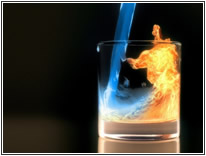
You are here: Home >> History of Light >> The two-slits experiment
One of the most dramatic and interesting demonstrations of the wave behaviour of electrons comes from the double-slit experiment. This experiment consists of a barrier set between a source of electrons and an electron detector. The barrier contains two slits, each about the width of the de Broglie wavelength of an electron. On this small scale, the wave nature of electrons becomes evident, as described in the following paragraphs.
Scientists can determine whether the electrons are behaving like waves or like particles by comparing the results of double-slit experiments with those of similar experiments performed with visible waves and particles. To establish how visible waves behave in a double-slit apparatus, physicists can replace the electron source with a device that creates waves in a tank of water. The slits in the barrier are about as wide as the wavelength of the water waves. In this experiment, the waves spread out spherically from the source until they hit the barrier.  The waves pass through the slits and spread out again, producing two new wave fronts with centres as far apart as the slits are. These two new sets of waves interfere with each other as they travel toward the detector at the far end of the tank.
The waves pass through the slits and spread out again, producing two new wave fronts with centres as far apart as the slits are. These two new sets of waves interfere with each other as they travel toward the detector at the far end of the tank.
The waves interfere constructively in some places (adding together) and destructively in others (cancelling each other out). The most intense waves - that is, those formed by the most constructive interference - hit the detector at the spot opposite the midpoint between the two slits. These strong waves form a peak of intensity on the detector. On either side of this peak, the waves destructively interfere and cancel each other out, creating a low point in intensity. Further out from these low points, the waves are weaker, but they constructively interfere again and create two more peaks of intensity, smaller than the large peak in the middle. The intensity then drops again, as the waves destructively interfere. The intensity of the waves forms a symmetrical pattern on the detector, with a large peak directly across from the midpoint between the slits and alternating low points and smaller and smaller peaks on either side.
To see how particles behave in the double-slit experiment, physicists replace the water with marbles. The barrier slits are about the width of a marble, as the point of this experiment is to allow particles (in this case, marbles) to pass through the barrier. The marbles are put in motion and pass through the barrier, striking the detector at the far end of the apparatus. The results show that the marbles do not interfere with each other or with themselves like waves do. Instead, the marbles strike the detector most frequently in the two points directly opposite each slit.
When physicists perform the double-slit experiment with electrons, the detection pattern matches that produced by the waves, not the marbles. These results show that electrons do have wave properties. However, if scientists run the experiment using a barrier whose slits are much wider than the de Broglie wavelength of the electrons, the pattern resembles the one produced by the marbles. This shows that tiny particles such as electrons behave as waves in some circumstances and as particles in others.